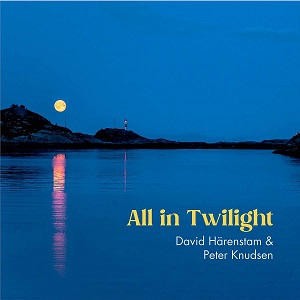
All in Twilight
David Härenstam (guitar)
Peter Knudsen (piano)
rec. 2014-2022, various venues
Daphne DAPHNE1081 [50]
Swedish guitarist David Härenstam has since the 1990s had a busy international career, as solo guitarist as well as member of various ensembles. His recording debut came as early as 2001 and since then his discography steadily grown. I have had the pleasure to review several of his productions. He always surprises with choice of repertoire. This is the fifth album that has come my way, and here he returns to his musical roots: jazz. That’s where he started his musical career before switching to classical guitar. Jazz pianist Peter Knudsen also feels at home in both camps and so they decided to combine them in a cross-over “between classical contemporary music and contemporary jazz improvisation” as the press release says.
The title of the album, All in Twilight, is derived from the work with the same title by Tōru Takemitsu (1930 – 1996), probably the most famous Japanese composer of Western art music. He composed the four-movement suite in 1987 for the British guitarist and lutenist Julian Bream. In this arrangement for guitar and piano all the original notes are there, but distributed between the two instruments, and improvisation is also important. Takemitsu, who was basically autodidact, was influenced by names like Debussy and Messiaen, but he also listened to American jazz music on the radio in his youth and thus knew the principles for this genre. There is a distinct nocturnal atmosphere in most of this suite, and Peter Knudsen very often plays in the descant register of the instrument which creates an effect of tiny bells tinkling – somewhat like Arvo Pärt’s tintinnabula technique. It is meditative and soothing – and fascinating.
From Asia to Sweden and the province of Dalecarlia, where I happen to live. The folk music tradition is deeply rooted here, and many are the composers who got inspiration from the songs and dances of the region. Hugo Alfvén was one and the somewhat younger Erland von Koch (1910 – 2009) another. Both composed large-scale orchestral works based on Dalecarlian folk music, and von Koch also wrote a series of variations for guitar on the well-known Visa från Utanmyra, a melody that became a great hit in the 1960s when jazz pianist Jan Johansson recorded it. Here Härenstam and Knudsen have arranged it as a dialogue between guitar and piano and also extemporize in between. Having known this melody in Johansson’s version since my youth, it was a pleasure to revive old memories – or, as the liner notes elegantly express it: “One of the ambitions with the improvised sections in this version is to bring out some of the Johansson-esque elements that are embedded in the DNA of von Koch’s piece.”
Stefan Klaverdal’s newly written piece needs an explanation concerning the title Thin Places. “In Celtic tradition ‘thin places’ are spots in the landscape where the distance between this world and others are closer or the veil between is thin.” There is certainly an otherworldly atmosphere here, transparent, beautiful, mystical, enhanced by electronic sounds, played by the composer. Electronic sounds might be frightening and lifeless, but here they seem to belong to a better world. We all need comfort in the cruel world of today, and here is some to savour.
Roland Dyens (b. 1955) is a well-known name – at least among guitar aficionados – not least through the often played and recorded Tango en Skai from 1985. The year after, he composed a three movement suite titled Libra Sonatine. The last movement, Fuoco (fire), was the opening number on Härenstam’s 2015 Recital – a disc that was a RECORDING OF THE MONTH in December that year. About Fuoco I wrote: “It is rhythmically thrilling with some exotic seasoning and – at the end – some percussive sounds. Very inviting – a winner.” I have several times returned to that disc and, among other titles, that specific piece. Here it is again, that specific recording, but with piano overdubs recorded by Peter Knudsen five years later. Fuoco swings along with the same enticing glow but with an extra dimension added. Really fascinating! I do urge readers to acquire the recital for comparison, and in the bargain you’ll more than an hour of fabulous guitar music (review).
Peter Knudsen’s brand new Dépaysement is a tribute to French 20th century composers from a couple of generations back, like Ravel and Dutilleux, both of whom had an interest in jazz. So this is again an example of the fleeting boundaries between jazz and classical music. And so is the final number on this disc, Duke Ellington’s In a Sentimental Mood, a real jazz standard if ever there was one. It also ties together the programme with the beginning, bearing in mind that Takemitsu allegedly named Ellington one of his main teachers, together with Debussy and Nature. This version of In a Sentimental Mood is based on an arrangement for guitar by Jason Vieaux , but with added solos for piano and guest bassist Svante Söderqvist.
As always, when David Härenstam is involved in a project, one can expect the unexpected. He is exploring new or unknown repertoire, new ways of expression, and with like-minded musicians, like Peter Knudsen, the results are illuminating eye-openers. That’s the case here too – and the technical brilliance and musicianship of all involved can be taken for granted. Readers hitherto unfamiliar with him should take the risk to be hooked forever.
Göran Forsling
Help us financially by purchasing from

Contents
Takemitsu, Toru (1930-1996)
All in Twilight – I
All in Twilight – II
All in Twilight – III
All in Twilight – IV
Koch, Erland von (1910-2009)
Utanmyra-variationer
Klaverdal, Stefan (b. 1975)
Thin Places
Dyens, Roland (1955-2016)
Fuoco
Knudsen, Peter (b. 1980)
Dépaysement
Ellington, Edward Kennedy ‘Duke’ (1899-1974)
In a Sentimental Mood
Other performers: Stefan Klaverdal (live electronics) (track 6); Svante Söderqvist (double bass) (track 9)


















